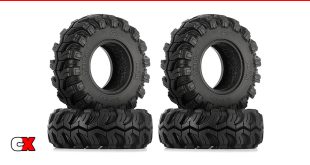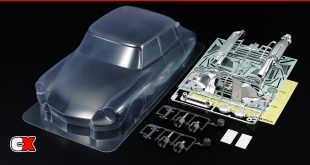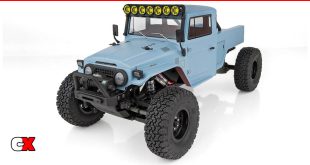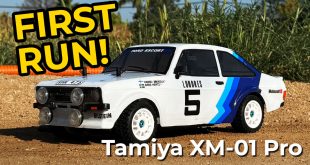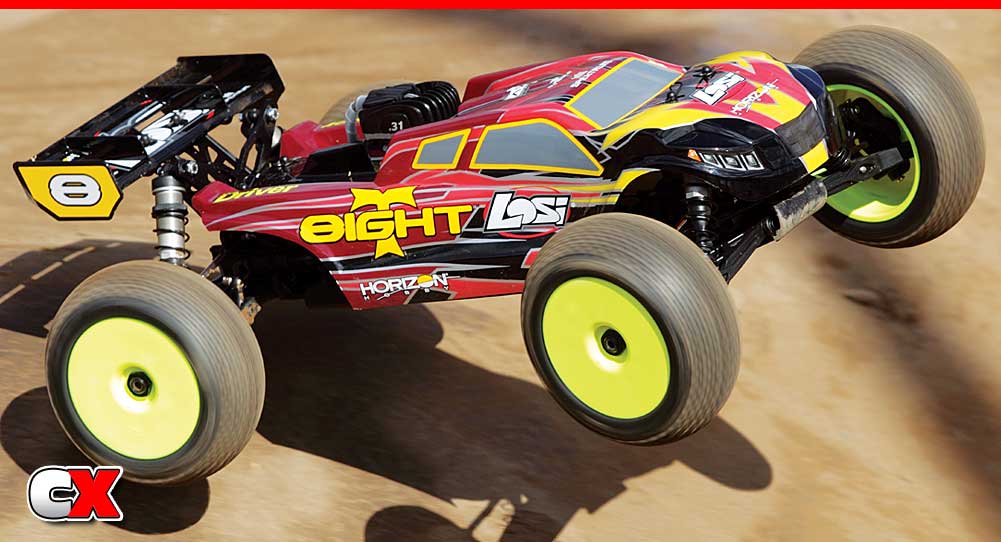
I consider myself a pretty competent RC fanatic; I can drive, tune, build and even properly instruct someone (sometimes) on how to do something. The one thing that I just can’t seem to wrap my head around though is nitro tuning. I don’t know what it is; I get the concept and understand the needle settings, but for some reason when it comes time to drive one, my engine tuning and understanding skills fly right out the window. This pretty much keeps me out of the 1/8-scale class (unless I’m driving an E-buggy or truggy), which kind of bums me out because I really love these cars. I am, however, big into 1/5-scale where the engines run on gas and are much easier to tune. When I heard that Losi was combining these two vehicle types, of course I put my hand up to review one of them. Lucky for me, the gas truggy was up for grabs so I immediately jumped at the chance to take it for a spin.
AT A GLANCE
WHO MAKES IT: Losi
WHO IT’S FOR: Intermediate to Experienced Drivers
PART NUMBER: LOS04001
HOW MUCH: $879.99
BUILD TYPE: RTR
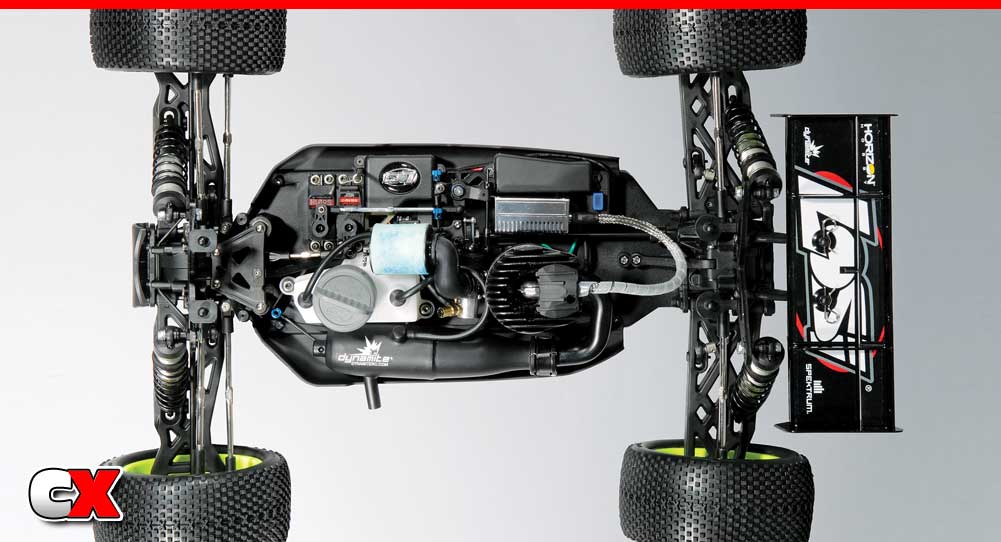
FEATURE BREAKDOWN
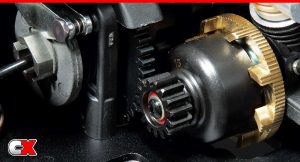 • This truck is based on TLR’s 8IGHT-T 3.0 nitro truggy. Losi starts with an anodized 7075-T6 aluminum chassis plate and adds molded dirt guards on both sides. Rigid, plastic chassis braces at both ends of the truck reach up to the gearboxes to reduce flex. The front half of the radio tray remains the same, incorporating side-by-side mounts for the Spektrum S6100 steering servo and S601H throttle servo. The rear half of the radio tray has been modified to accept a small, LiPo receiver pack as well as the ignition module. This module is pretty big but Losi did a good job of making it fit without taking up a lot of room. Moving to the opposite side of the chassis, the first thing to catch your eye is the enormous, spin-off fuel tank lid (it actually might have been the first thing to catch your eye when you took the body off!). It does appear to be a bit of an eyesore, but remember this isn’t a nitro truck. Gasoline is a harsh fuel that will eat its way through most o-rings in nitro fuel guns, so you’ll need to fill this truck using a 1:1 scale gas can. Those cans dispense fuel with a large-mouth spout, so the opening in the fuel tank needs to be able to accept that. Trust me, it will grow on you. I already see its size as commonplace.
• This truck is based on TLR’s 8IGHT-T 3.0 nitro truggy. Losi starts with an anodized 7075-T6 aluminum chassis plate and adds molded dirt guards on both sides. Rigid, plastic chassis braces at both ends of the truck reach up to the gearboxes to reduce flex. The front half of the radio tray remains the same, incorporating side-by-side mounts for the Spektrum S6100 steering servo and S601H throttle servo. The rear half of the radio tray has been modified to accept a small, LiPo receiver pack as well as the ignition module. This module is pretty big but Losi did a good job of making it fit without taking up a lot of room. Moving to the opposite side of the chassis, the first thing to catch your eye is the enormous, spin-off fuel tank lid (it actually might have been the first thing to catch your eye when you took the body off!). It does appear to be a bit of an eyesore, but remember this isn’t a nitro truck. Gasoline is a harsh fuel that will eat its way through most o-rings in nitro fuel guns, so you’ll need to fill this truck using a 1:1 scale gas can. Those cans dispense fuel with a large-mouth spout, so the opening in the fuel tank needs to be able to accept that. Trust me, it will grow on you. I already see its size as commonplace.
• Rejoice when I tell you that Losi’s fantastic 3.0 suspension has carried over to the gas 8IGHT-T. This includes items like long, thick suspension arms, heavy duty steering knuckles, caster blocks and rear hubs as well as durable turnbuckles. The shock towers feature the same geometry as the 3.0, however they are stamped aluminum instead of the TLR machined parts. The gas 8IGHT-T uses the same 16mm shock bodies as the 3.0, but includes plastic shock caps and standard shafts instead of the groovy upgraded parts. That doesn’t matter, though, as the suspension feels absolutely dialed both on the bench and out on the track. Trust me when I say you won’t need those upgrades to go fast!
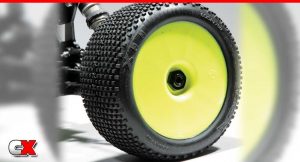 • The steering consists of a pair of ball bearing supported bellcranks that feature an integrated servo saver. Controlling the front wheels is Spektrum’s S6100, high-voltage metal-geared servo. This little bugger posts some big numbers; a stout 361oz/in of torque with a speed of .11 seconds. It’s well up to the task of keeping the 8IGHT-T pointed in the right direction, especially when I turned the AVC (Active Vehicle Control) all the way down and started driving this truck like I stole it. We’ll talk a little more about that during the test drive section.
• The steering consists of a pair of ball bearing supported bellcranks that feature an integrated servo saver. Controlling the front wheels is Spektrum’s S6100, high-voltage metal-geared servo. This little bugger posts some big numbers; a stout 361oz/in of torque with a speed of .11 seconds. It’s well up to the task of keeping the 8IGHT-T pointed in the right direction, especially when I turned the AVC (Active Vehicle Control) all the way down and started driving this truck like I stole it. We’ll talk a little more about that during the test drive section.
• The gas 8IGHT-T steals the drivetrain from the 3.0 as well. Fluid-filled differentials are housed in the diff cases at both ends as well as in the center of the truggy. Up front, 4mm CVD’s extend out to the bearing supported front axles, while 3mm dogbones are used to drive the center and rear axles. The gas version doesn’t include the lightweight outdrives, but they are a TLR option you can upgrade to later if you feel the need.
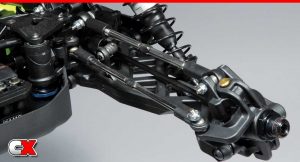 • As you might expect, the most exciting part of this truck is the Dynamite .31cc gasoline engine. Size-wise, it’s not all the different from a standard nitro engine. It sets down roughly the same footprint and sticks out the body about the same, the only difference is the cool looking braided ignition coil wire running to the CDI unit. The head is machined to accept maximum airflow over it to cool the engine, and a plastic ‘cap’ helps protect it and the coil wire. A 4-shoe, brass flywheel is mounted to the front of the engine (complete with cooling fins) and a Dynamite performance tuned pipe is mounted to the back for expelling the exhaust. Finally, you’ll notice some additional wiring exiting the CDI for the timing sensor on the flywheel.
• As you might expect, the most exciting part of this truck is the Dynamite .31cc gasoline engine. Size-wise, it’s not all the different from a standard nitro engine. It sets down roughly the same footprint and sticks out the body about the same, the only difference is the cool looking braided ignition coil wire running to the CDI unit. The head is machined to accept maximum airflow over it to cool the engine, and a plastic ‘cap’ helps protect it and the coil wire. A 4-shoe, brass flywheel is mounted to the front of the engine (complete with cooling fins) and a Dynamite performance tuned pipe is mounted to the back for expelling the exhaust. Finally, you’ll notice some additional wiring exiting the CDI for the timing sensor on the flywheel.
PROS
+ Cheaper fuel!
+ Based on the stellar TLR 8IGHT-T 3.0
+ Adjustable AVC system installed
+ Powerful Dynamite .31 gasoline engine
+ Metal-geared servos
+ Massive 150cc capacity fuel tank
+ Plush 16mm aluminum shocks
+ Waterproof electronics and receiver box
+ Starter box and LiPo receiver pack included
+ Compatible with TLR upgrade parts
CONS
– Requires Horizon’s proprietary 2-cycle pre-mix oil
– The ignition module cable rubs on the rear drive axle
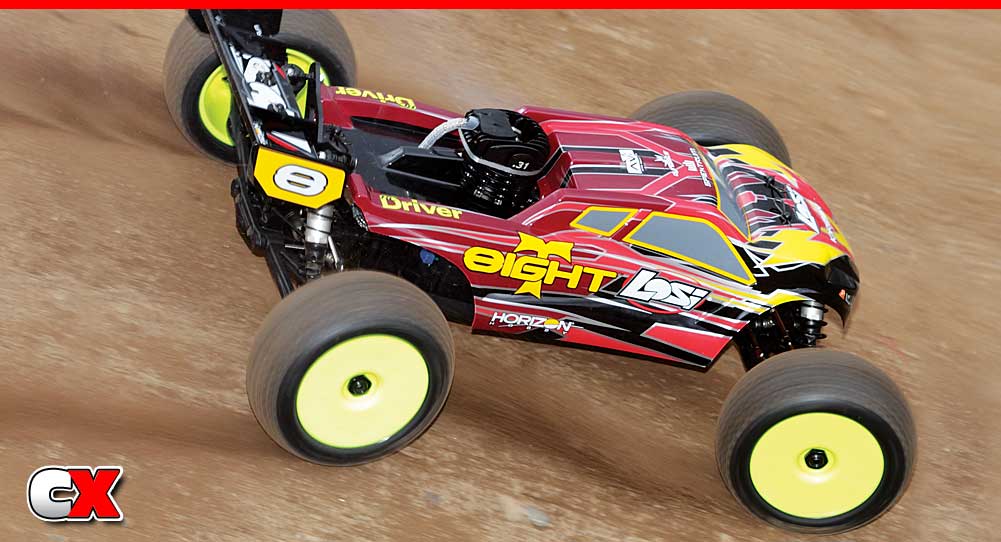
ON THE TRACK
The first thing I need to mention here is that, when you pull this truck out of the box and are ready to run it, FOLLOW THE ENGINE BREAK-IN PROCEDURE. Yes, I know it’s long and requires at least 8 full tanks (yes, 8 as in 8IGHT), but this is crucial for peak engine performance. Unfortunately, being a dood I didn’t read those and had some issues, but luckily I was able to revert back to the break-in procedure and get things running right. Thankfully, Losi also included two small containers of the pre-mix oil (good for about 12 tanks).
Now that I had the engine running right and producing good power, it was time to put it on the track to see how it performed. We made our way to Wolcott Raceway just in time to take the Losi on the new track layout. There was a nice long straight, double and triple jumps and a few switchbacks; perfect to test both low- and high-speed tendencies of the gas engine. I turned everything on, propped the truggy on the included starter box and after one solid push, the 8IGHT-T roared to life. I love the sound of a gas engine in the morning!
STEERING
On the first tank, I noticed the 8IGHT-T had quite a bit of push for my taste. In the corners, I had to wait on it a bit to rotate through before I could get back in the throttle. The steering response was definitely fast enough, but this just seemed a little odd to me and I assumed it was the tires not having enough grip. On the second tank, I rotated the dial to turn the AVC off and the steering came alive. It was now much more aggressive into and out of the corners and I could use the throttle to initiate a slight drift. I played with the AVC a little and found a sweet spot where it would allow aggressive steering while still keeping the truck under control.
ACCELERATION/ BRAKING
On the initial drive, the 8IGHT-T felt really good around most of the track. On the straight, speeds were comparable, if not exceeding, most sport engines. It did feel a little sluggish out of the corners, but nothing that would prevent me from clearing any of the jumps. I fiddled with the engine settings a bit and that helped, but I still felt like it needed a little more grunt. Tank two was a different story. Once the AVC was off, it felt like I could keep the RPMs up higher, resulting in spunkier acceleration. Maybe it was the AVC or maybe my driving style, but whatever it was, the 8IGHT-T felt great! If I hit the right line, I could carry way more speed onto the straight. A few of the onlookers were asking if it was gas or nitro, a pretty good testament to how fast it was.
HANDLING/JUMPING
Since this is basically a 3.0 TLR Truggy with AVC, you can about imagine how well it’s going to handle. The AVC, turned all the way up, has so much control over the truggies conduct that you’re really going to have to do something wrong to get this truck out of shape. I drove it pretty hard and numerous times felt the AVC kick in, but unfortunately that made me feel a little disconnected from it. On the second tank of running with the AVC off, the truggy seemed way more agile and a little more out of control, but I felt more in tune with it. Again, finding the AVC sweet spot allowed me to pitch the car into corners or over jumps to help set up for the next corner without losing control. One section I found where the AVC actually helped out was a slight off-camber, uphill tabletop just before a turn. If I hit it a little too fast (with the AVC off), I would have to sometimes brake and countersteer to get the truck under control before making the corner. With the AVC on, it would do both of those things for me – I just turned the wheel and powered away.
DURABILITY
There’s a funny thing 1/8-scalers do when they’re about to crash – they just mash the throttle and power out of their predicament. I understand the concept, but it is one of those things I have a hard time doing for fear of breaking something. As I drove around the track, I did have a few mishaps where I just let the truck crash. Greg would look at me and say “When the truck is about to crash, that’s when you grab full throttle”. Bizarre approach, so when I tried it I expected to see diff gears or dogbones ejecting from all sides of the 8IGHT-T. Nope, nothing. Just big, spinning tires clawing at the ground and flipping me right-side-up. If that’s not going to break something, I can honestly say that I’m not sure what will. Off the track, I did a quick analysis of the truck and found that everything looked great … everything except the coil wire. When the body is installed, the wire gets pushed down and, on hard landings, it sags momentarily and rubs against the spinning rear driveshaft. The braided sleeve has started to unravel, so I’ll have to find a solution to secure it out of the way. I wouldn’t really consider this a durability issue as much as a fitment issue. It’s just something to keep your eye on.
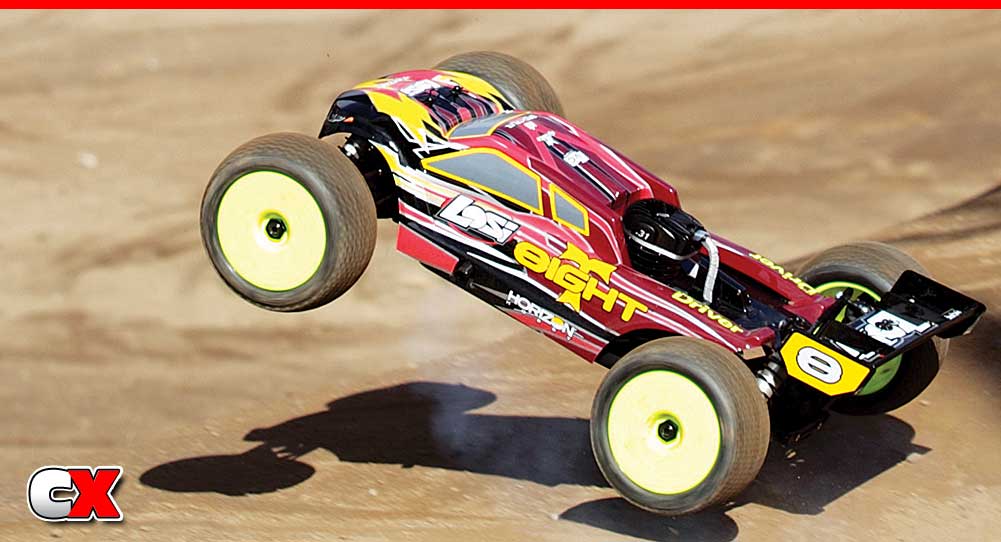
SPECS & TUNING OPTIONS
DIMENSIONS
LENGTH: 18.75 in. (476mm)
WIDTH: 16.38 in. (416.1mm)
HEIGHT: 7.3 in. (185.5mm)
GROUND CLEARANCE: 2.6 in. (66mm)
WHEELBASE: 14.93-15.09” (379-383mm)
WEIGHT: 9.75 lb. (4.4kg)
BODY, WHEELS AND TIRES
BODY: Pre-painted and mounted 8IGHT-T 3.0 body
WHEELS: Plastic dish-design
WHEEL ADAPTER TYPE: 17mm hex
TIRES: 5.6 in. Hard XTT
SUSPENSION
TYPE: 4-wheel independent
SHOCK POSITIONS: (F) 3-tower, 2-arm, (R) 3-tower, 3-arm
CAMBER: Adjustable turnbuckles
ROLL: Adjustable tower locations
WHEELBASE: Adjustable with shims
RIDE HEIGHT: Threaded shocks
STEERING
TYPE: Dual bellcrank
TOE: Turnbuckles
CHASSIS
TYPE: Flat
MATERIAL: Anodized 7075-T6 aluminum
THICKNESS: 4mm
DRIVETRAIN
TYPE: 4WD
TRANSMISSION: N/A
DIFFERENTIAL: Three fluid-filled gear diffs
GEAR RATIO: Optional clutch bells
BEARINGS: Full shielded
CLUTCH TYPE: 4-shoe
THE LAST WORD
So I really haven’t told you what the benefits are of gas over nitro. First, let’s look at the cost. 91 Octane gas on average (depending on where you are) is roughly $3.50 a gallon. Add Dynamite’s Small Block 2-Cycle Pre-Mix Oil (282ml, or roughly 1 gallon) at around $12 a bottle and you have a total of about $16 invested in gas. Compare that to a gallon of nitro fuel which can run you between $30-40 a gallon, and we haven’t even added a fuel gun. On top of that, gas engines are easier to tune than nitro engines, making this a much more viable option for a beginner looking to get into fuel-powered vehicles. I’m convinced. Time to gas up and go racing!
LINKS
Losi, losi.com, (877) 504-0233
Dynamite, dynamiterc.com, (877) 504-0233
E-flite, e-fliterc.com, (877) 504-0233
 CompetitionX CompetitionX is the most up-to-date source for RC Car News, Reviews and Videos for Radio Control. We also have the most comprehensive Manual Database on the web.
CompetitionX CompetitionX is the most up-to-date source for RC Car News, Reviews and Videos for Radio Control. We also have the most comprehensive Manual Database on the web. 









